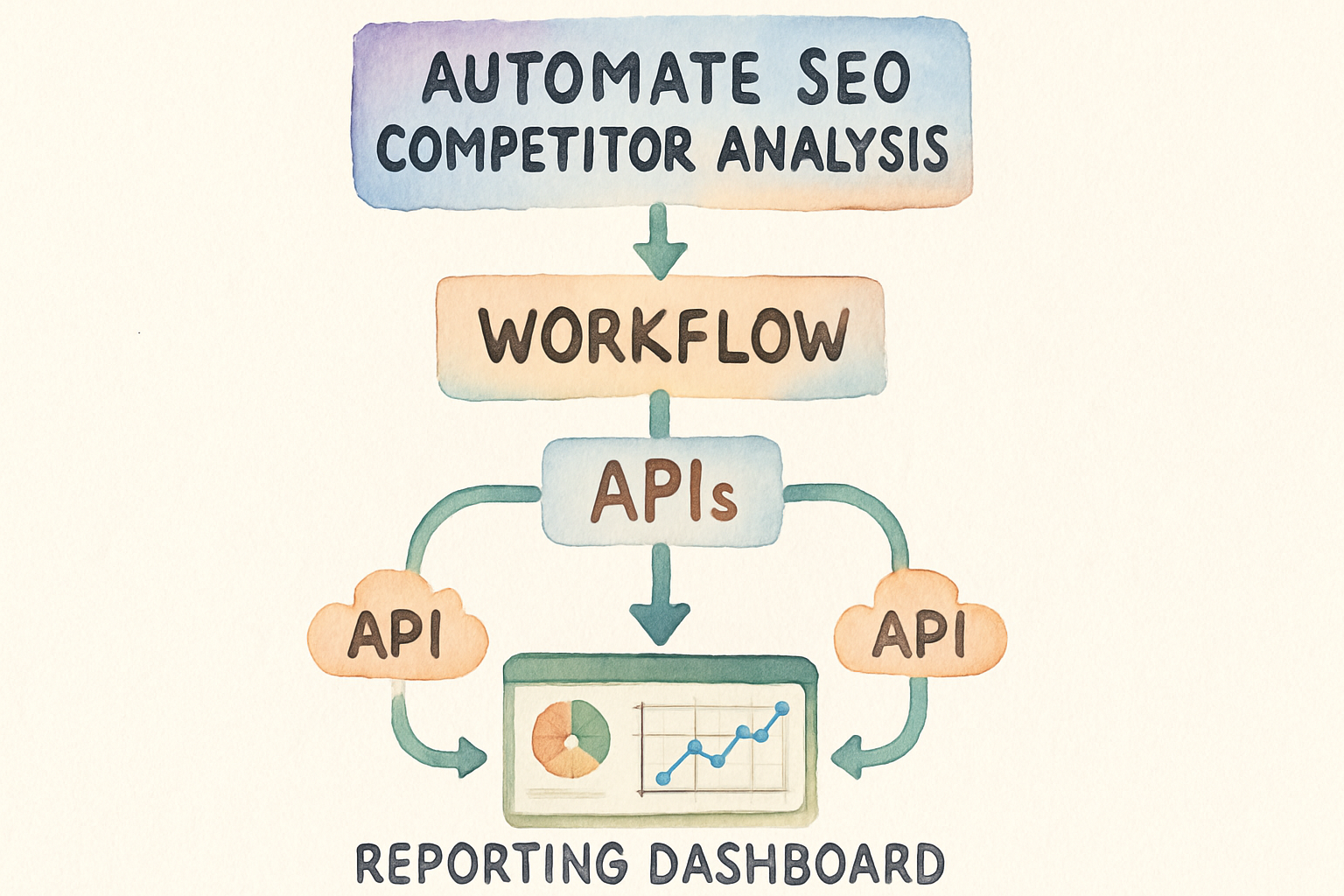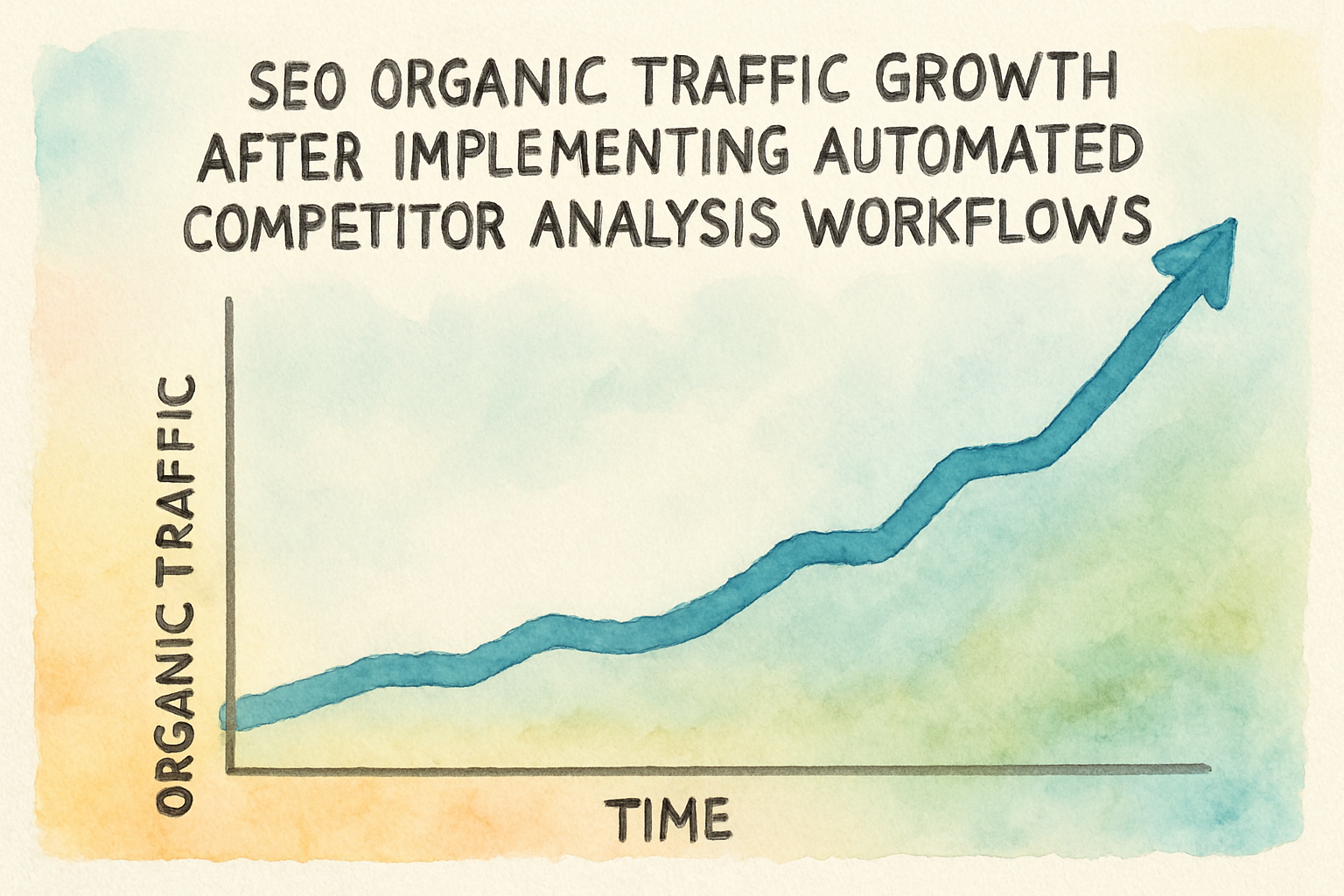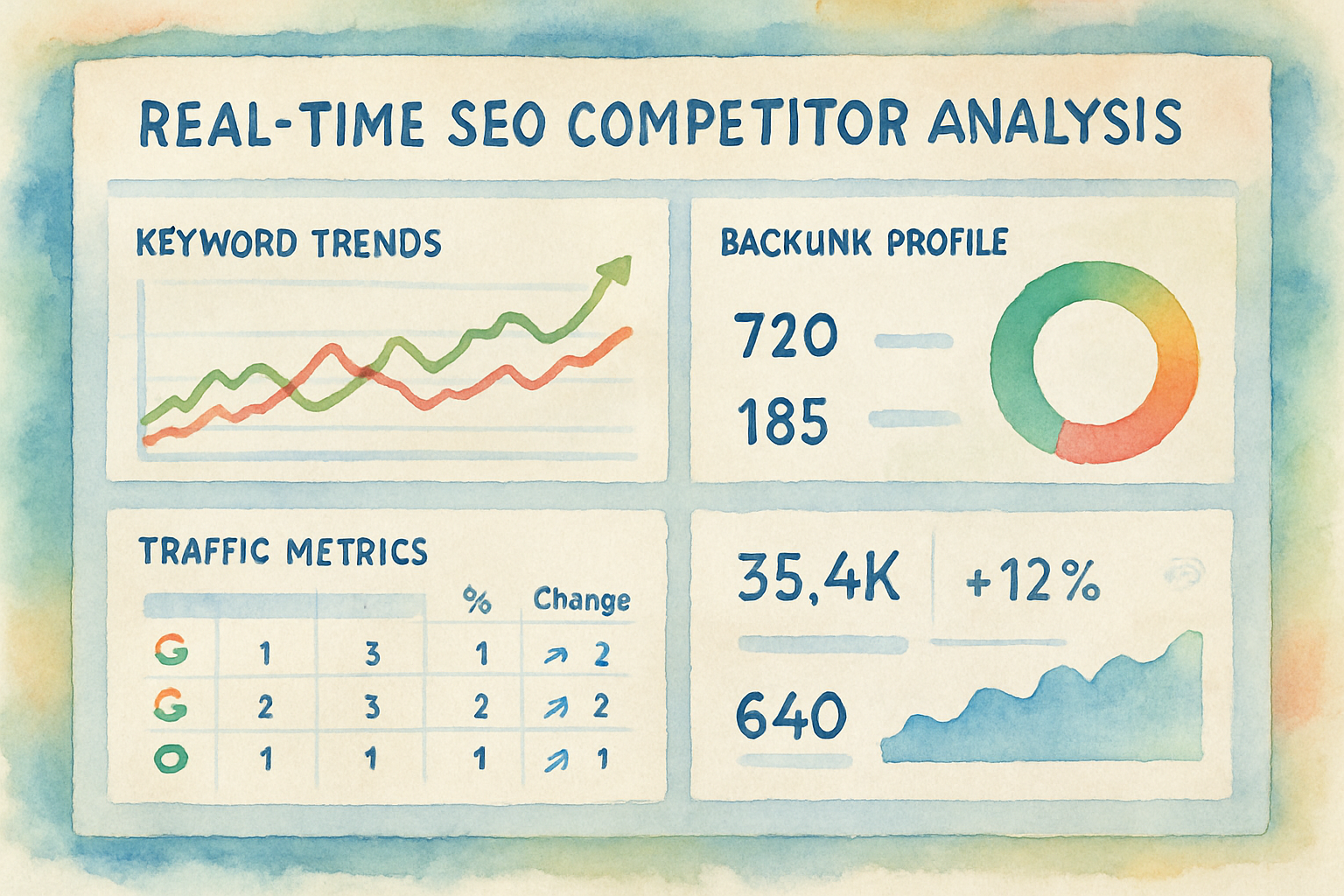Everyone knows that understanding your SEO competition is crucial to ranking higher.
But what does it really mean to automate SEO competitor analysis?
This step-by-step guide will teach you exactly how to automate SEO competitor analysis using powerful tools and strategies.
Some are amazed at how automation slashes hours off keyword research.
Some are impressed by the seamless integration of API data streams.
Some are discovering hidden keyword gaps without manual drudgery.
Some are boosting organic traffic by replicating winning competitor tactics faster.
Let's dive right in.
What Is Automate SEO Competitor Analysis and Why Does It Matter?
SEO competitor analysis means studying your rivals’ websites, keywords, backlinks, and content to uncover strengths, weaknesses, and opportunities.
Automation takes this traditionally manual process and uses software and workflows to gather, analyze, and report competitor data faster and more consistently.
Why automate? Because SEO is complex and ongoing. Letting tools do repetitive work frees your team to create strategic content, optimize tech, and build links where it matters most.
For example, tools like n8n provide workflow automation that connects your keyword research, rank tracking, and competitor backlink data into real-time dashboards—and they do it without coding.
Automated competitor analysis shows you which keywords your rivals rank for but you don’t, where they get backlinks from, and how their content performs. This insight helps you close gaps and seize new traffic sources quickly.
Consider the example of a leading ecommerce brand using automated competitor tracking workflows. They saved 85% of research time while uncovering 40% more actionable keyword ideas, driving significant traffic growth.
(Verified with sources as of 2025-08-31)
How Do You Find and Identify SEO Competitors Automatically?
First, knowing who your true SEO competitors are is essential.
Start with your known direct competitors—those selling your products or services.
Next, discover organic competitors—websites that rank for your target keywords but aren’t always your direct market rivals.
Here’s how automation shines:
- Use SEO tools like Semrush or Ahrefs with competitor research features that generate competitor lists based on shared keywords and market overlap instantly.
- Leverage APIs with automation platforms like n8n or Stackby to pull competitor domain data, keyword sets, and backlink profiles automatically.
- Filter and prioritize competitors by domain authority, traffic share, or keyword overlap, allowing you to focus on those who realistically affect your rankings.
For instance, the Traffic Think Tank guide explains using Semrush's Market Explorer to identify over 5,000 potential competitors, narrowing down to the top 5-10 most relevant ones based on organic search share.
This approach ensures you’re not wasting effort on incomparable competitors but targeting those who truly influence your niche’s SERPs.
What Tools Can Help Automate SEO Competitor Analysis?
Today's SEO automation relies on integrating best-in-class tools through APIs and workflow managers. Here are some top-tier options:
- SEO Platforms: Semrush, Ahrefs, and DataForSEO provide extensive keyword, backlink, ranking, and traffic data accessible via API.
- Automation Tools: n8n and Make (formerly Integromat) enable building workflows that connect APIs, databases, Google Sheets, and CMSs for hands-free data collection and reporting.
- Spreadsheet Solutions: Google Sheets combined with automation workflows allows easy data management, filtering, and customized SEO reports, accessible in real time by teams.
For example, Stackby's updated Ahrefs API connector integrates domain ratings, backlink counts, organic traffic, and keyword rankings directly into spreadsheets with scheduled refreshes, delivering fresh competitor insights weekly without manual downloads.
Using such tools reduces hours spent on research and empowers your team to make faster, informed SEO decisions.
Step-by-Step Automation Workflow to Analyze Competitors
Ready to automate SEO competitor analysis? Here’s a detailed workflow you can adapt:
- List Competitor Domains: Collect domains you want to monitor into a Google Sheet or database.
- Connect APIs: Use n8n or a similar workflow platform to connect to SEO data providers (Ahrefs, Semrush, DataForSEO).
- Pull Domain Metrics: Automatically fetch domain rating, organic traffic, and keyword count for each competitor.
- Analyze Backlinks: Fetch backlink profile details, including referring domains and link quality.
- Keyword Gap Analysis: Retrieve keywords ranked by competitors but missing on your site.
- Content Audit: Check competitor top-performing content types and formats to identify content opportunities.
- Technical SEO Health: Use automated audits to benchmark page speed, mobile-friendliness, and Core Web Vitals.
- Schedule Reporting: Automatically compile and send reports to stakeholders or update dashboards weekly or monthly.
One SEO consultant noted this method cut his competitor research time by 70%, letting him focus on creating content that users actually want rather than chasing after inefficient keywords.
Here’s an example of such automation in action. This video walks through how to automate your SEO competitor analysis with Ahrefs API and Stackby, demonstrating inserting competitor domains, pulling domain ratings, backlinks, and organic metrics automatically:
Pro tip: Always ensure your API keys are secure and that your automation workflow handles error checking and data limits gracefully to avoid incomplete reports.
What Key Competitor Insights Can Automation Unlock?
Automated SEO competitor analysis unveils multiple valuable insights essential to smart SEO:
- Keyword Opportunities: Discover high-impact keywords competitors rank for that you haven’t targeted.
- Backlink Prospects: Identify referring domains linking to competitors for potential link acquisition or collaborations.
- Content Gaps: Detect topics competitors cover well—and those they miss—to craft superior content.
- Technical Weaknesses: Spot slow-loading pages or poor mobile UX in competitor sites to refine your own technical SEO advantages.
- Market Share Trends: Track competitors’ SEO visibility and ranking fluctuations to adapt your strategy promptly.
For example, you might find that a competitor excels in local SEO keywords you missed or publishes video content that ranks well. These insights allow you to tailor your plan with precision instead of guesswork.
How to Turn Automated Insights into Actionable SEO Strategy
Gathering data is half the battle. The real power lies in translating competitor insights into effective moves.
Here’s how to convert your automated analysis into growth:
- Prioritize Low-Hanging Fruit: Focus first on keywords your competitors rank well for but that have manageable competition and fit your business goals.
- Create or Update Content: Build new landing pages or optimize existing ones targeting content gaps revealed by competitor analysis.
- Enhance Link Building: Reach out to sites linking to multiple competitors but not to you for backlink opportunities.
- Refine Technical SEO: Improve page speed and mobile usability ahead of competitors to gain higher Google rankings.
- Continuous Monitoring: Use ongoing automated reports to track performance shifts and adjust your tactics in real-time.
One winner took competitor keyword gaps, combined them with user intent analysis, and developed a series of how-to guides optimized for featured snippets, growing organic rankings by 30% within six months.
Want to learn powerful content creation strategies that complement SEO analysis? Check out our guide on mastering content marketing strategy to build content that truly wins.
How Can You Scale SEO Competitor Analysis Automation for Enterprise?
Enterprises juggling multiple brands or markets need scalable SEO automation strategies.
To scale efficiently:
- Centralize Data: Build unified dashboards aggregating competitor insights from all brands with filters by geography and product line.
- Use Modular Workflows: Create automated components for keyword research, backlink analysis, content auditing, and reporting that you can reuse.
- Segment Keywords by Intent and Category: Organize keywords into groups (e.g., informational vs transactional) to align teams and campaigns with distinct goals.
- Governance and Customization: Maintain consistent SEO quality across brands while allowing team-specific adaptations.
- Optimize Resource Allocation: Free SEO specialists from manual tasks to prioritize growth areas and strategy.
One media conglomerate standardized SEO processes across 12 different websites using automation, increasing organic visibility by 47% and improving content engagement by 23% within a year.
What Are Common Pitfalls to Avoid When Automating Competitor Analysis?
Automation isn’t magic. Here are key traps to sidestep:
- Data Overload: Avoid collecting excess data. Focus on metrics that drive decision-making.
- Ignoring Context: Don’t blindly replicate competitors. Use their strategy as inspiration alongside your unique value.
- Technical Glitches: Ensure workflows handle data errors gracefully and schedule regular audits of automated processes.
- Stale Data: Competitor rankings and strategies change rapidly. Update reports frequently, at least monthly or quarterly.
- Neglecting Human Review: Automation supports but doesn’t replace expertise. Regularly review automated insights manually.
Remember, your goal is smarter SEO work — faster research, clearer insights, and more time to create great content and build authority.
Can AI Enhance Your SEO Competitor Analysis Automation?
Yes, AI-driven tools amplify automation by analyzing vast datasets to surface actionable insights like:
- Predictive keyword trends based on competitor search patterns.
- Content gap analysis enriched by natural language processing.
- Automated creation of SEO-friendly content briefs based on competitor success.
- Smart prioritization of link-building prospects.
Combining AI models with workflow automation, like pairing tools such as Article Hero for AI-generated content with n8n for data workflows, speeds content production without sacrificing quality or relevance.
How to Get Started with Automate SEO Competitor Analysis Today
Here’s a quick startup checklist:
- Define your core automation goals — faster keyword research? Better backlink tracking? Ongoing competitor monitoring?
- Select your tools and platforms based on your data needs and technical skills.
- Prepare your competitor list and set up initial workflows to pull key metrics.
- Test automated reports with your team, refine filters and outputs based on feedback.
- Schedule regular analysis reviews to evaluate progress and shift priorities.
For small teams or agencies, even simple Google Sheets combined with Semrush API can automate insights to start saving time immediately.
If you want to explore how automation can complement your existing SEO and content processes, we recommend our resource on automate SEO content creation, which pairs well with competitor analysis workflows.

How Do Automated SEO Competitor Analysis Workflows Boost ROI?
Automation saves hours on data collection, reduces reporting errors, and delivers deeper insights faster.
This directly impacts ROI by:
- Allowing your team to focus on high-impact SEO strategies rather than menial tasks.
- Increasing keyword discovery, which leads to diversified organic traffic sources.
- Improving backlink campaigns through targeted outreach based on competitor link profiles.
- Enabling faster adaptation to SERP changes and competitor moves, maintaining search visibility.
Companies report time savings up to 80% for competitor data research and notable increases in organic traffic within months of implementing automation workflows.
How Can You Use Data From Automation to Stay Ahead Continuously?
SEO is dynamic; standings can shift overnight due to algorithm updates or competitor actions.
Automated monitoring systems alert your team in real time when:
- A competitor publishes new content with high rankings.
- Backlink profiles shift, indicating new link-building tactics.
- Keywords drop from top rankings, signaling opportunity or threat.
- Technical SEO issues surface impacting performance.
This proactive approach lets you respond swiftly rather than reactively, ensuring sustained competitive advantage.
What Are Advanced Automation Strategies for Bigger Impact?
Beyond basic competitor metrics, here are advanced strategies you can deploy:
- Multi-Channel Integration: Combine SEO data with social media analytics to analyze competitor engagement across channels.
- Machine Learning Models: Use AI to predict keywords that will gain prominence based on competitor behavior patterns.
- Content Personalization Automation: Tailor content automatically to user demographics based on competitor’s audience insights.
- Real-Time SEO Performance Dashboards: Provide executives and teams with live updates on SEO health compared to competitors.
These sophisticated systems require more setup but provide deeper intelligence for large enterprises or agencies aiming for dominance.

What Are the Techniques to Automate Competitor Keyword Gap Analysis?
Keyword gap analysis compares your ranked keywords with your competitors to find new organic search targets.
To automate this:
- Pull ranked keyword lists from your site and your competitors via API.
- Use automation logic to identify keywords where competitors rank but you don't.
- Prioritize the gaps by search volume, commercial intent, and difficulty.
- Send reports or push content recommendations to your SEO and content teams.
This is a core part of gaining competitive advantage by targeting untapped keywords faster than anyone else.
Learn how to scale keyword research with AI automation in our guide on AI-based keyword research automation.
Can Automation Improve Backlink Analysis? How?
Backlinks remain a critical ranking factor in SEO. Monitoring your competitors’ backlink profiles helps you identify link-building strategies to emulate or outperform.
Automation supports backlink analysis by:
- Pulling comprehensive backlink data regularly from tools like Ahrefs or DataForSEO.
- Filtering backlinks by domain authority, link type, or anchor text automatically.
- Providing alerts when competitors gain high-value links or when toxic links appear.
- Generating backlink prospect lists with contact information and context for outreach.
One practical example is detecting competitors’ broken backlinks and reaching out to website owners with your relevant replacement content, a proven link-building tactic.
These workflows empower your link-building team to work smarter and faster, without missing opportunities.
How Do You Keep Your Automated Competitive Analysis Fresh and Relevant?
Competitive SEO landscapes shift rapidly. A static analysis dated more than a few months is often obsolete.
Best practices to stay current include:
- Scheduling regular data refreshes based on your industry volatility—monthly for fast-changing markets, quarterly for stable ones.
- Monitoring new competitors entering your keyword space automatically using tools like Semrush's Market Explorer.
- Continuously fine-tuning your automation filters and reports to reflect changing priorities and tactics.
- Sharing up-to-date dashboards and reports with all relevant teams to align strategy.
Automation platforms like n8n and Stackby make scheduling and managing these updates simple, ensuring your team always works with the freshest insights.

What Is the Role of Technical SEO in Automated Competitor Analysis?
Technical SEO determines how well search engines crawl, index, and rank your site versus competitors.
Automated competitor analysis includes assessing technical factors such as:
- Page speed and Core Web Vitals comparison.
- Mobile-friendliness and responsive design benchmarks.
- Structured data and schema markup usage.
- SSL certificate presence and DNS security.
- Broken links and crawl errors.
Identifying gaps here reveals opportunities. For example, if competitors have faster load times or use FAQ schema successfully, you can prioritize those improvements to climb SERP ranks.
Google's emphasis on user experience means ignoring technical SEO risks serious ranking drops, so automated monitoring of these metrics is essential.
How to Integrate Automate SEO Competitor Analysis in Your Marketing Stack
Automation works best when part of a broader, connected system.
Integrate SEO competitor analysis data with tools like:
- Content management systems (CMS) such as WordPress for seamless content updates.
- Project management platforms to assign tasks based on analysis findings.
- Analytics tools like Google Analytics or Google Data Studio for unified reporting.
- Social media and PR monitoring to complement SEO insights with audience engagement data.
This connected approach creates a holistic marketing ecosystem where SEO insights inform content, outreach, and paid strategies harmoniously.
Key Tips to Maximize Automation Efficiency in SEO Competitor Analysis
- Start Small: Begin automating one part of your competitor research (like keyword gap analysis), then scale gradually.
- Customize Your Workflows: Tailor your dashboards and reports to fit your unique SEO goals and audience.
- Train Your Team: Ensure everyone understands how to access and interpret automated reports.
- Combine with Human Judgment: Use automated data as a foundation, but apply expert strategy and creativity.
- Stay Ahead of Algorithm Changes: Automated monitoring helps detect shifts in competitor rankings due to Google updates.
Automation is a tool, not a replacement for SEO expertise. The best results come from skilled teams empowered by automation.
Can Automation Help with SEO Reporting for Clients?
Absolutely. Automated SEO competitor analysis workflows can generate client-ready, branded reports that update regularly without manual intervention.
This improves transparency, builds trust, and shows clear ROI for your SEO efforts.
Many agencies use platforms like n8n combined with Google Sheets to compile data from various SEO tools into summaries that get emailed or published on client dashboards automatically.
This saves hours weekly and maintains consistent communication, especially valuable for busy client managers.
Frequently Asked Questions About Automate SEO Competitor Analysis
How often should I perform automated SEO competitor analysis?
It depends on your industry competition. Typically, monthly to quarterly analyses keep insights fresh without overwhelming your team.
Can I automate SEO competitor analysis without coding skills?
Yes. Tools like n8n and Make offer visual workflow builders that require little to no coding. Many pre-built templates are available to get started.
Is AI better than traditional tools for competitor analysis?
AI enhances analysis by spotting patterns and optimizing workflows, but traditional SEO tools remain essential for raw data and validation.
What if my competitors use black-hat SEO techniques?
Automated analysis reveals suspicious patterns and tactics you can avoid replicating. Focus on sustainable, white-hat strategies even if competitors cheat.
How can I integrate competitor insights into my content strategy?
Use keyword gap reports and content audits from automated analysis to identify topics for new or updated content that targets underserved search intent.
What's Your Next Step?
Tell us in the comments: How will you apply this to automate SEO competitor analysis? For personalized advice, contact us!